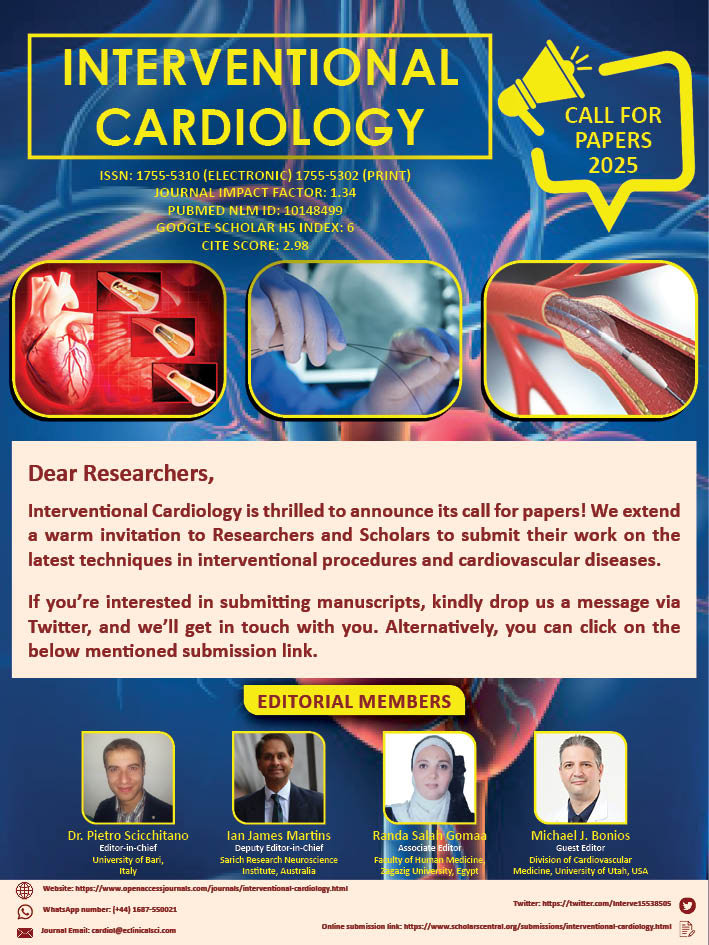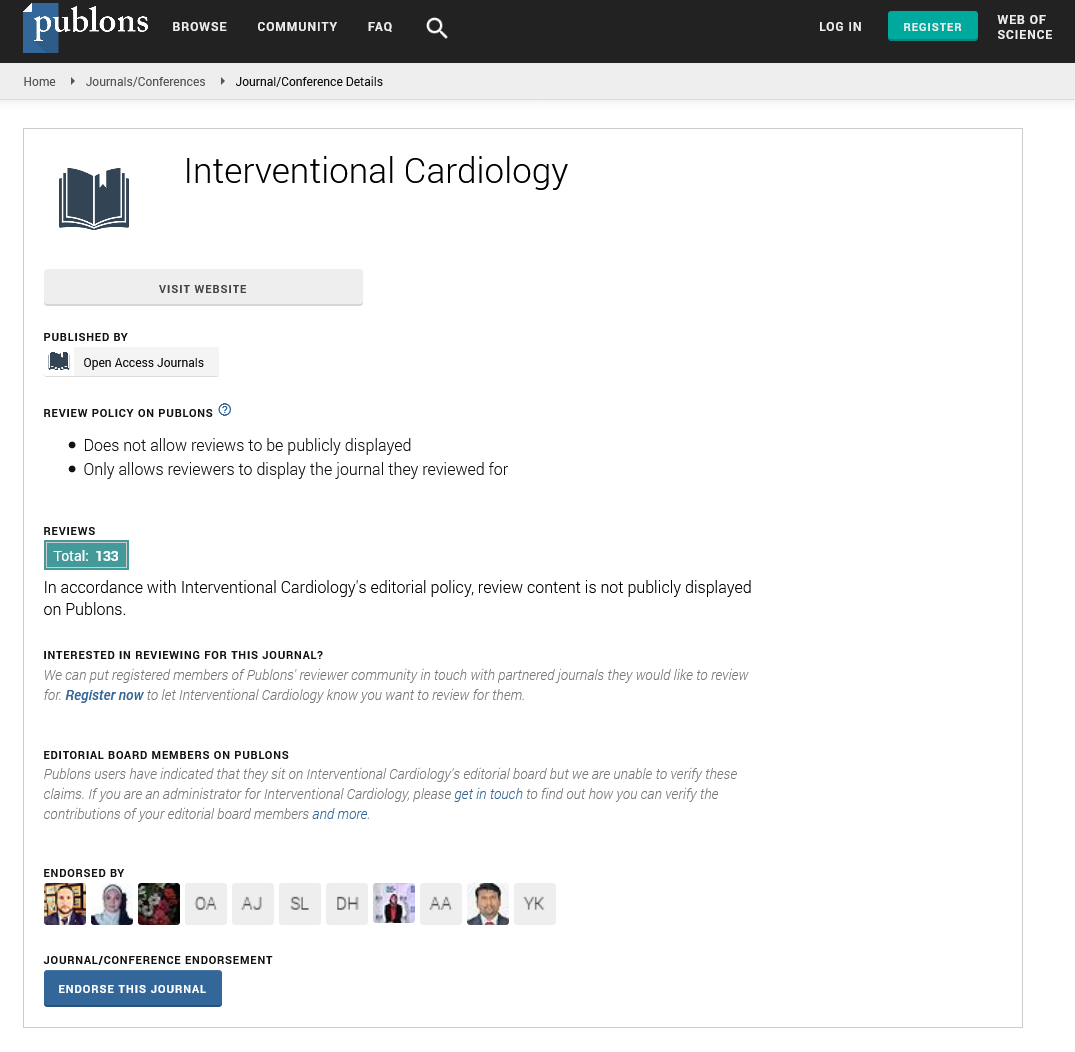Short Communication - Interventional Cardiology (2025) Volume 17, Issue 2
Microcirculation Function in Non-ST-elevation Myocardial Infarction after the Index Event and at Follow-Up
- Corresponding Author:
- Luis Manuel Vilardouro Paiva
Hospital Geral-Quinta dos Vales, 3041-801 Coimbra, Portugal
E-mail: luisvpaiva@gmail.com
Received date: 03-Mar-2025, Manuscript No. FMIC-25-165666; Editor assigned: 05-Mar-2025, PreQC No. FMIC-25-165666 (PQ); Reviewed date: 19-Mar-2025, QC No. FMIC-25-165666; Revised date: 26-Mar-2025, Manuscript No. FMIC-25-165666 (R); Published date: 02-Apr-2025, DOI: 10.37532/1755- 5310.2025.17(2).982
Abstract
Research on coronary physiology in acute coronary syndromes has predominantly focused on patients with ST-Segment Elevation Myocardial Infarction (STEMI) and the significance of Fractional Flow Reserve (FFR), often disregarding the prevalence of microvascular dysfunction following Non-ST-Elevation Myocardial Infarction (NSTEMI). Paiva, et al. made a significant contribution to the understanding of coronary microvascular function following NSTEMI. This study evaluated a cohort of patients with NSTEMI using a combination of invasive physiological indices: FFR, Coronary Flow Reserve (CFR), and Index of Microcirculatory Resistance (IMR) in the MI culprit coronary artery. These assessments were conducted at the time of the index ischemic event and during the follow-up period, with a median duration of 7 months after MI. The key findings included a high prevalence of abnormal CFR during the acute phase of MI, whereas extensive microcirculatory dysfunction (IMR>40) was uncommon. Over the follow-up period, there was a significant reduction in the prevalence of abnormal CFR values (<2.0) and extensive microcirculatory resistance (IMR<40). In patients presenting a CFR below 2.0 and an IMR under 25, the observed decrease in CFR was attributed to an increase in resting coronary blood flow rather than a reduction in hyperemic flow. During the acute phase of NSTEMI, an abnormal CFR was frequently observed in the MI culprit coronary artery, whereas extensive microcirculatory resistance was infrequent in this cohort. Microvascular dysfunction in the MI culprit coronary artery improved during the follow-up period. Patients with low CFR and low IMR did not experience compromised microvascular vasodilation following ischemic injury.
Keywords
Microvascular vasodilation . Ischemic injury . Coronary physiology
Introduction
Non-ST-Elevation Myocardial Infarction (NSTEMI) accounts for a substantial proportion of acute coronary syndromes, which are characterized by several underlying pathophysiological processes and varying levels of risk for death and Major Adverse Cardiac Events (MACE) [1]. Although much attention has been given to epicardial coronary artery disease, the role of microcirculatory dysfunction and its evolution in NSTEMI remain understudied. Paiva et al. presented a significant contribution to the understanding of coronary microvascular function in NSTEMI [2]. They conducted a prospective study involving patients with NSTEMI and assessed coronary microvascular function immediately after the initial ischemic event (acute phase) and at follow-up (>6 months post-MI). This study provides insights into the persistence and recovery of microcirculatory impairment and its association with biomarkers and adverse outcomes.
Discussion
This study represents a preliminary investigation of type 1 NSTEMI involving a cohort of 30 participants. It offers a comprehensive invasive physiological evaluation of coronary epicardial and microcirculatory functions in the MI culprit coronary artery using FFR, CFR, and the index of IMR. The coronary procedure was usually conducted on the first day of the index hospitalization (IQR [0,2] days) and was repeated during the follow-up period, with a median interval of 7 months (IQR [7,10] months). It is important to note that the assessment of the coronary microcirculation was systematically performed after the Percutaneous Coronary Intervention (PCI) of the affected vessel. Coronary angiographic findings of acute plaque rupture, acute vessel occlusion, or intracoronary imaging indicative of an acute coronary lesion were the main findings used to identify type 1 MI and affected coronary vessels. Very high-risk NSTEMI patients (i.e., shock) and patients with Coronary Artery Disease (CAD) anatomy considered for Coronary Artery Bypass Grafting (CABG) were not included in this study.
Multivessel CAD was frequently observed (53%), the right coronary artery was the most common MI culprit coronary artery (40%), and PCI usually involved the placement of only one stent (median stent diameter and length were 2.75 mm and 23 mm, respectively). The FFR measurements of the MI culprit coronary artery remained stable between the initial and follow-up invasive assessments. Additionally, the resting and hyperemic mean transit times (Tmn) did not significantly change between the initial and follow-up procedures, and no significant correlation was observed between the number, size, or length of the stent implanted and Tmn. Coronary microvascular dysfunction was mostly identified by an abnormal CFR (<2.0) in 60% of patients with NSTEMI. Extensive microvascular resistance (IMR>40U) was infrequently found, occurring in 17% of cases. Over time, there was a significant reduction in the prevalence of abnormal CFR (26%, p=0.013) and extensive microvascular resistance (4%, p=0.030) in the MI culprit coronary artery compared to baseline. Moreover, the left anterior descending artery was the culprit coronary artery that most frequently presented with an abnormal CFR (78%). In contrast, the circumflex coronary artery did not demonstrate severe microvascular resistance (IMR>40U), which may be attributed to the typically smaller infarct size associated with the circumflex myocardial blood supply. Furthermore, the occurrence of slow-reflow phenomena in the index PCI and anterior MI was associated with the persistence of abnormal IMR at follow-up (p<0.001 and p=0.030, respectively). Peak troponin levels during the initial hospitalization were higher in patients with multivessel CAD and showed a positive trend with IMR measurements (r=0.405, p=0.061).
Additionally, an IMR>40 at follow-up was significantly associated with higher peak troponin levels (9399 ng/mL vs. 35000 ng/ mL; p=0.013) during hospital admission. However, FFR, CFR, and IMR did not correlate with adverse clinical events (death and hospital readmission due to MI or heart failure) during the median follow-up period of 50 months after hospitalization. This lack of correlation can be explained by the limited sample size, relatively minor myocardial damage after NSTEMI, as indicated by the well-preserved Left Ventricular (LV) ejection fraction (median, 57%) following MI, and the exclusion of very high-risk NSTEMI patients.
Overall, this study offers a comprehensive physiological analysis of patients with NSTEMI employing a multimodal physiological assessment of FFR, CFR, and IMR. Additionally, its longitudinal design facilitated the observation of changes in microvascular function over time following myocardial ischemia. Type 1 NSTEMI typically manifests as a non-occlusive thrombus in the culprit coronary artery, resulting in subendocardial injury to the heart tissue. Following an ischemic event, the LV may experience adverse structural changes (remodeling), including thinning of the infarcted myocardium, LV dilatation, and eccentric hypertrophy of the remote healthy myocardium, ultimately leading to contractility dysfunction over time. The extent of ischemia and LV remodeling is often greater in STEMI than in NSTEMI because of the larger MI size and transmural injury pattern, which are critical determinants of post-MI morbidity and mortality [3, 4]. Thus, in the case of MI characterized by reduced myocardial damage and fibrosis, a less severe and more reversible form of microvascular dysfunction may be expected. Nevertheless, the precise mechanisms linking subendocardial infarct size to LV shape and functional changes in NSTEMI remain incompletely understood [5].
CFR indicates the capacity of a vascular bed to dilate during hyperemia, and an impaired CFR (<2.0) is associated with an increased risk of all-cause mortality and MACE. Moreover, IMR is a thermodilution technique that allows the quantitative assessment of microcirculatory resistance within a coronary artery territory, which can be elevated (= 25U) in the setting of acute MI due to microvascular blockage, extravascular compression from interstitial edema, and intramyocardial bleeding. Abnormal CFR and IMR values correlate inconsistently with infarct size and microvascular injury in the literature, and prognostic data for CFR and IMR are largely derived from studies on STEMI, which characteristically presents with transmural myocardial damage [6]. The present study demonstrated that microvascular dysfunction is commonly observed in the acute phase of NSTEMI and often persists in patients 6 months after MI. Additionally, abnormal CFR and IMR seemed to improve over time, likely due to changes in the microvasculature, since the occurrence of new angiographic coronary lesions was rarely observed, and FFR measurements remained stable over time, suggesting no significant progression of epicardial coronary disease during the follow-up period. Nonetheless, the persistence of abnormal CFR and IMR in some patients warrants further research into risk stratification and targeted therapies for NSTEMI [7].
The CFR is defined as the ratio of hyperemic to resting Coronary Blood Flow (CBF). However, it cannot be determined whether an impaired CFR measurement results from an elevated resting CBF, reduced hyperemic CBF, or a combination of both factors. Additionally, the NSTEMI cohort was divided into four physiological subtypes based on CFR (<2.0 vs. = 2.0) and IMR (<25 vs. = 25U). When comparing patients with low CFR/low IMR to the ânormalâ physiological subtype (high CFR/low IMR), we found that those with low CFR and IMR did not experience impaired microvascular vasodilation following ischemic injury. Rather, these patients presented with an increase in baseline CBF. The underlying causes of elevated resting CBF remain unclear. However, this may imply non-microvascular factors, such as metabolic inefficiency or nitric oxide dysregulation [8, 9]. Finally, our results advocate for the consistent incorporation of CBF evaluation into the physiological assessment of coronary arteries, as treatments aimed at enhancing vasodilatation may not benefit patients with increased resting CBF. An alternative therapeutic approach for this subtype of microvascular dysfunction might involve targeting decreased myocardial efficiency, such as through the use of SGLT2 inhibitors or addressing uncoupled coronary blood flow with antiplatelet agents [10].
Conclusion
During the acute phase of NSTEMI, an abnormal CFR was frequently observed in the MI culprit coronary artery, whereas extensive microcirculatory resistance was infrequent. Microvascular dysfunction in the MI culprit coronary artery improved during the follow-up period. Patients with low CFR and low IMR did not experience compromised microvascular vasodilation following ischemic injury. Extensive microcirculatory dysfunction was associated with higher peak troponin levels. However, CFR and IMR were not associated with adverse clinical events during the follow-up period in patients with NSTEMI.
References
- Collet JP, Thiele H, Barbato E, et al. 2020 ESC Guidelines for the management of acute coronary syndromes in patients presenting without persistent ST-segment elevation: The task force for the management of acute coronary syndromes in patients presenting without persistent ST-segment elevation of the European Society of Cardiology (ESC). Eur Heart J. 42(14):1289-1367 (2021).
- Paiva L, Gutiérrez E, Ferreira MJ, et al. Microcirculation function in non-ST-elevation myocardial infarction after the index event and at follow-up. CJC Open.
- Chan MY, Sun JL, Newby LK, et al. Long-term mortality of patients undergoing cardiac catheterization for ST-elevation and non-ST-elevation myocardial infarction. Circulation. 119(24):3110-3117 (2009).
- Stiermaier T, Backhaus SJ, Lange T, et al. Cardiac magnetic resonance left ventricular mechanical uniformity alterations for risk assessment after acute myocardial infarction. J Am Heart Assoc. 8(16):e011576 (2019).
- Matter MA, Paneni F, Libby P, et al. Inflammation in acute myocardial infarction: The good, the bad and the ugly. Eur Heart J. 45(2):89-103 (2024).
- Silva M, Paiva L, Teixeira R, et al. Microcirculation function assessment in acute myocardial infarction: A systematic review of microcirculatory resistance indices. Front Cardiovasc Med. 9:1041444 (2022).
- Heusch G. Myocardial ischaemia-reperfusion injury and cardioprotection in perspective. Nat Rev Cardiol. 17(12):773-789 (2020).
- Picchi A, Limbruno U, Focardi M, et al. Increased basal coronary blood flow as a cause of reduced coronary flow reserve in diabetic patients. Am J Physiol Heart Circ Physiol. 301(6):H2279- H2284 (2011).
- Rahman H, Ryan M, Lumley M, et al. Coronary microvascular dysfunction is associated with myocardial ischemia and abnormal coronary perfusion during exercise. Circulation. 140(22):1805-1816 (2019).
- Nardone M, McCarthy M, Ardern CI, et al. Concurrently low coronary flow reserve and low index of microvascular resistance are associated with elevated resting coronary flow in patients with chest pain and nonobstructive coronary arteries. Circ Cardiovasc Interv. 15(3):e011323 (2022).

